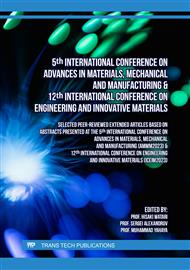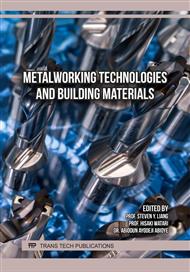[1]
J.J. Lewandowski, M. Seifi, Metal Additive Manufacturing: A Review of Mechanical Properties, Annu. Rev. Mater. Res. 46 (2016) 151–186.
DOI: 10.1146/annurev-matsci-070115-032024
Google Scholar
[2]
W.J. Sames, F.A. List, S. Pannala, R.R. Dehoff, S.S. Babu, The metallurgy and processing science of metal additive manufacturing, Int. Mater. Rev. 61 (2016) 1–46.
DOI: 10.1080/09506608.2015.1116649
Google Scholar
[3]
D.D. Gu, W. Meiners, K. Wissenbach, R. Poprawe, Laser additive manufacturing of metallic components: materials, processes and mechanisms, Int. Mater. Rev. 57 (2012) 133–164.
DOI: 10.1179/1743280411y.0000000014
Google Scholar
[4]
R.Z. Valiev, M.J. Zehetbauer, Y. Estrin, H.W. H??ppel, Y. Ivanisenko, H. Hahn, G. Wilde, H.J. Roven, X. Sauvage, T.G. Langdon, The innovation potential of bulk nanostructured materials, Adv. Eng. Mater. 9 (2007) 527–533.
DOI: 10.1002/adem.200700078
Google Scholar
[5]
T.G. Langdon, Processing of ultrafine-grained materials using severe plastic deformation: Potential for achieving exceptional properties, Rev. Metal. 44 (2008) 556–564.
DOI: 10.3989/revmetalm.0838
Google Scholar
[6]
R. Valiev, Nanostructuring of metals by severe plastic deformation for advanced properties, Nat. Mater. 3 (2004) 511–516.
DOI: 10.1038/nmat1180
Google Scholar
[7]
K. Edalati, Z. Horita, A review on high-pressure torsion (HPT) from 1935 to 1988, Mater. Sci. Eng. A. 652 (2016) 325–352.
DOI: 10.1016/j.msea.2015.11.074
Google Scholar
[8]
J. Wongsa-Ngam, M. Kawasaki, T.G. Langdon, Achieving homogeneity in a Cu-Zr alloy processed by high-pressure torsion, J. Mater. Sci. 47 (2012) 7782–7788.
DOI: 10.1007/s10853-012-6587-8
Google Scholar
[9]
K. Edalati, M. Ashida, Z. Horita, T. Matsui, H. Kato, Wear resistance and tribological features of pure aluminum and Al-Al2O3 composites consolidated by high-pressure torsion, Wear. 310 (2014) 83–89.
DOI: 10.1016/j.wear.2013.12.022
Google Scholar
[10]
Y. Estrin, A. Vinogradov, Extreme grain refinement by severe plastic deformation: A wealth of challenging science, Acta Mater. 61 (2013) 782–817.
DOI: 10.1016/j.actamat.2012.10.038
Google Scholar
[11]
S. Mohd Yusuf, Y. Chen, S. Yang, N. Gao, Microstructural evolution and strengthening of selective laser melted 316L stainless steel processed by high-pressure torsion, Mater. Charact. 159 (2020) 110012.
DOI: 10.1016/j.matchar.2019.110012
Google Scholar
[12]
S. Mohd Yusuf, Y. Chen, N. Gao, Influence of High-Pressure Torsion on the Microstructure and Microhardness of Additively Manufactured 316L Stainless Steel, Metals (Basel). 11 (2021) 1–12.
DOI: 10.3390/met11101553
Google Scholar
[13]
A. Hosseinzadeh, A. Radi, J. Richter, T. Wegener, S.V. Sajadifar, T. Niendorf, G.G. Yapici, Severe plastic deformation as a processing tool for strengthening of additive manufactured alloys, J. Manuf. Process. 68 (2021) 788–795.
DOI: 10.1016/j.jmapro.2021.05.070
Google Scholar
[14]
P. Snopiński, K. Matus, F. Tatiček, S. Rusz, Overcoming the strength-ductility trade-off in additively manufactured AlSi10Mg alloy by ECAP processing, J. Alloys Compd. 918 (2022).
DOI: 10.1016/j.jallcom.2022.165817
Google Scholar
[15]
K.S. Mukhtarova, R. V. Shakhov, V. V. Smirnov, S.K. Mukhtarov, Microstructure and microhardness studies of Inconel 718, manufactured by selective laser melting and subjected to severe plastic deformation and annealing, IOP Conf. Ser. Mater. Sci. Eng. 672 (2019).
DOI: 10.1088/1757-899x/672/1/012049
Google Scholar
[16]
Y. Huang, T.G. Langdon, The evolution of delta-phase in a superplastic Inconel 718 alloy, J. Mater. Sci. 42 (2007) 421–427.
DOI: 10.1007/s10853-006-0483-z
Google Scholar
[17]
S.Mohd Yusuf, N. Mazlan, N.H. Musa, X. Zhao, Y. Chen, S. Yang, N.A. Nordin, S.A. Mazlan, N. Gao, Microstructures and Hardening Mechanisms of a 316L Stainless Steel/Inconel 718 Interface Additively Manufactured by Multi-Material Selective Laser Melting, Met. MDPI. 13 (2023) 1–21.
DOI: 10.3390/met13020400
Google Scholar
[18]
J. Zhang, N. Gao, M.J. Starink, Al-Mg-Cu based alloys and pure Al processed by high pressure torsion: The influence of alloying additions on strengthening, Mater. Sci. Eng. A. 527 (2010) 3472-3479.
DOI: 10.1016/j.msea.2010.02.016
Google Scholar
[19]
A. Thorvaldsen, The intercept method—1. Evaluation of grain shape, Acta Mater. 45 (1997) 587–594.
DOI: 10.1016/s1359-6454(96)00197-8
Google Scholar
[20]
G.K. Williamson, R.E. Smallman, III. Dislocation densities in some annealed and cold-worked metals from measurements on the X-ray Debye-Scherrer spectrum, Philos. Mag. 1 (1956) 34-46.
DOI: 10.1080/14786435608238074
Google Scholar
[21]
W.M. Tucho, P. Cuvillier, A. Sjolyst-Kverneland, V. Hansen, Microstructure and hardness studies of Inconel 718 manufactured by selective laser melting before and after solution heat treatment, Mater. Sci. Eng. A. 689 (2017) 220–232.
DOI: 10.1016/j.msea.2017.02.062
Google Scholar
[22]
M.S. Pham, B. Dovgyy, P.A. Hooper, Twinning induced plasticity in austenitic stainless steel 316L made by additive manufacturing, Mater. Sci. Eng. A. 704 (2017) 102–111.
DOI: 10.1016/j.msea.2017.07.082
Google Scholar
[23]
G.A. Knorovsky, M.J. Cieslak, T.J. Headley, A.D. Romig, W.F. Hammetter, INCONEL 718: A solidification diagram, Metall. Trans. A. 20 (1989) 2149–2158.
DOI: 10.1007/bf02650300
Google Scholar
[24]
X. Sauvage, G. Wilde, S. V. Divinski, Z. Horita, R.Z. Valiev, Grain boundaries in ultrafine grained materials processed by severe plastic deformation and related phenomena, Mater. Sci. Eng. A. 540 (2012) 1–12.
DOI: 10.1016/j.msea.2012.01.080
Google Scholar
[25]
S. Scheriau, Z. Zhang, S. Kleber, R. Pippan, Deformation mechanisms of a modified 316L austenitic steel subjected to high pressure torsion, Mater. Sci. Eng. A. 528 (2011) 2776–2786.
DOI: 10.1016/j.msea.2010.12.023
Google Scholar
[26]
W. Wu, M. Song, S. Ni, J. Wang, Y. Liu, B. Liu, X. Liao, Dual mechanisms of grain refinement in a FeCoCrNi high-entropy alloy processed by high-pressure torsion, Sci. Rep. 7 (2017) 1–13.
DOI: 10.1038/srep46720
Google Scholar
[27]
H.E. Helmer, C. Körner, R.F. Singer, Additive manufacturing of nickel-based superalloy Inconel 718 by selective electron beam melting: Processing window and microstructure, J. Mater. Res. 29 (2014) 1987–1996.
DOI: 10.1557/jmr.2014.192
Google Scholar
[28]
M. Munther, T. Palma, F. Tavangarian, A. Beheshti, K. Davami, Nanomechanical properties of additively and traditionally manufactured nickel-chromium-based superalloys through instrumented nanoindentation, Manuf. Lett. 23 (2020) 39–43.
DOI: 10.1016/j.mfglet.2019.09.003
Google Scholar
[29]
X. Sauvage, S. Mukhtarov, Microstructure evolution of a multiphase superalloy processed by severe plastic deformation, IOP Conf. Ser. Mater. Sci. Eng. 63 (2014).
DOI: 10.1088/1757-899x/63/1/012173
Google Scholar
[30]
ASTM, ASTM G 102-89: Standard Practice for Calculation of Corrosion Rates and Related Information, 1999.
Google Scholar
[31]
S. Mohd Yusuf, M. Nie, Y. Chen, S. Yang, N. Gao, Microstructure and corrosion performance of 316L stainless steel fabricated by Selective Laser Melting and processed through high-pressure torsion, J. Alloys Compd. 763 (2018) 360–375.
DOI: 10.1016/j.jallcom.2018.05.284
Google Scholar
[32]
K.D. Ralston, N. Birbilis, Effect of grain size on corrosion, Corrosion. 66 (2010) 1–4.
Google Scholar
[33]
X. Wang, M. Nie, C.T. Wang, S.C. Wang, N. Gao, Microhardness and corrosion properties of hypoeutectic Al-7Si alloy processed by high-pressure torsion, Mater. Des. 83 (2015) 193–202.
DOI: 10.1016/j.matdes.2015.06.018
Google Scholar



